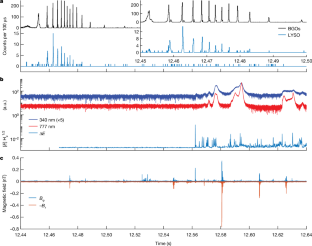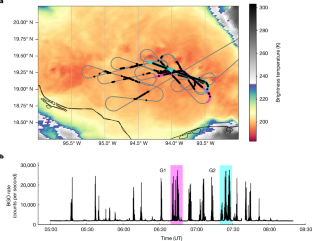2024-10-02 デューク大学(Duke)
<関連情報>
- https://pratt.duke.edu/news/radioactive-lightning/
- https://www.nature.com/articles/s41586-024-07893-0
- https://www.nature.com/articles/s41586-024-07936-6
揺らめくガンマ線フラッシュ、ガンマグローとTGFの間のミッシングリンク Flickering gamma-ray flashes, the missing link between gamma glows and TGFs
N. Østgaard,A. Mezentsev,M. Marisaldi,J. E. Grove,M. Quick,H. Christian,S. Cummer,M. Pazos,Y. Pu,M. Stanley,D. Sarria,T. Lang,C. Schultz,R. Blakeslee,I. Adams,R. Kroodsma,G. Heymsfield,N. Lehtinen,K. Ullaland,S. Yang,B. Hasan Qureshi,J. Søndergaard,B. Husa,D. Walker,… D. Mach
Nature Published:02 October 2024
DOI:https://doi.org/10.1038/s41586-024-07893-0

Abstract
Two different hard-radiation phenomena are known to originate from thunderclouds: terrestrial gamma-ray flashes (TGFs)1 and gamma-ray glows2. Both involve an avalanche of electrons accelerated to relativistic energies but are otherwise different. Glows are known to last for one to hundreds of seconds, have moderate intensities and originate from quasi-stationary thundercloud fields2,3,4,5. TGFs exhibit high intensities and have characteristic durations of tens to hundreds of microseconds6,7,8,9. TGFs often show a close association with an emission of strong radio signals10,11,12,13,14,15,16,17 and optical pulses18,19,20,21, which indicates the involvement of lightning leaders in their generation. Here we report unique observations of a different phenomenon, which we call flickering gamma-ray flashes (FGFs). FGFs resemble the usual multi-pulse TGFs22,23,24 but have more pulses and each pulse has a longer duration than ordinary TGFs. FGF durations span from 20 to 250 ms, which reaches the lower boundary of the gamma-ray glow duration. FGFs are radio and optically silent, which makes them distinct from normal TGFs. An FGF starts as an ordinary gamma-ray glow, then suddenly increases exponentially in intensity and turns into an unstable, ‘flickering’ mode with a sequence of pulses. FGFs could be the missing link between the gamma-ray glows and conventional TGFs, whose absence has been puzzling the atmospheric electricity community for two decades.
非常にダイナミックなガンマ線放出は熱帯の雷雲によく見られる Highly dynamic gamma-ray emissions are common in tropical thunderclouds
M. Marisaldi,N. Østgaard,A. Mezentsev,T. Lang,J. E. Grove,D. Shy,G. M. Heymsfield,P. Krehbiel,R. J. Thomas,M. Stanley,D. Sarria,C. Schultz,R. Blakeslee,M. G. Quick,H. Christian,I. Adams,R. Kroodsma,N. Lehtinen,K. Ullaland,S. Yang,B. Hasan Qureshi,J. Søndergaard,B. Husa,D. Walker,… A. Santos
Nature Published:02 October 2024
DOI:https://doi.org/10.1038/s41586-024-07936-6

Abstract
Thunderstorms emit fluxes of gamma rays known as gamma-ray glows1,2, sporadically observed by aircraft1,3,4,5,6,7, balloons8,9,10,11 and from the ground12,13,14,15,16,17,18. Observations report increased gamma-ray emissions by tens of percent up to two orders of magnitude above the background, sometimes abruptly terminated by lightning discharges1,3,4,5. Glows are produced by the acceleration of energetic electrons in high-electric-field regions within thunderclouds8 and contribute to charge dissipation3. Glows had been considered as quasi-stationary phenomena3,5,12, with durations up to a few tens of seconds and spatial scales up to 10–20 km. However, no measurements of the full extension in space and time of a gamma-ray-glow region and their occurring frequency have been reported so far. Here we show that tropical thunderclouds over ocean and coastal regions commonly emit gamma rays for hours over areas up to a few thousand square kilometres. Emission is associated with deep convective cores; it is not uniform and continuous but shows characteristic timescales of 1–10 s and even subsecond for individual glows. The dynamics of gamma-glowing thunderclouds strongly contradicts the quasi-stationary picture of glows and instead resembles that of a huge gamma-glowing ‘boiling pot’ in both pattern and behaviour.



